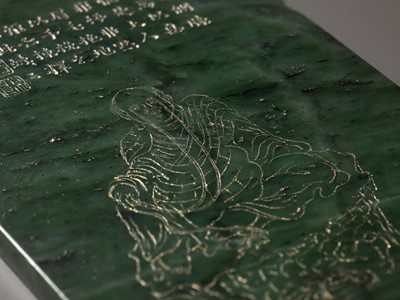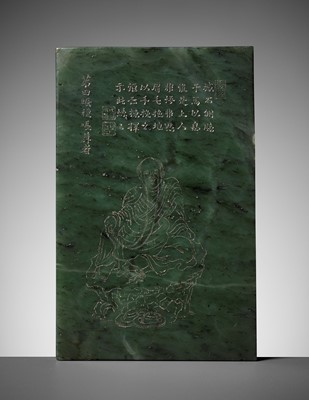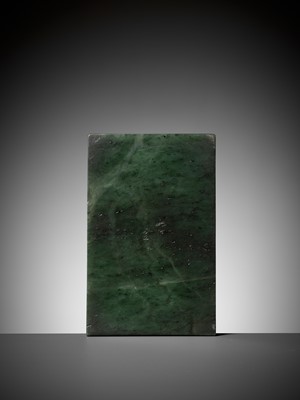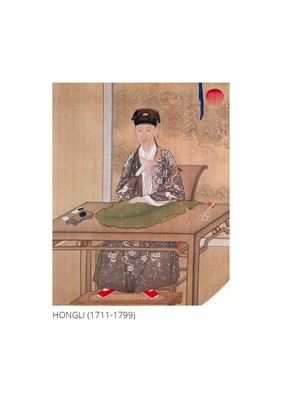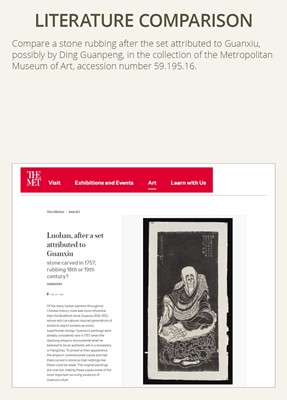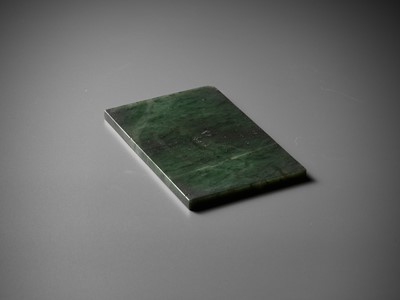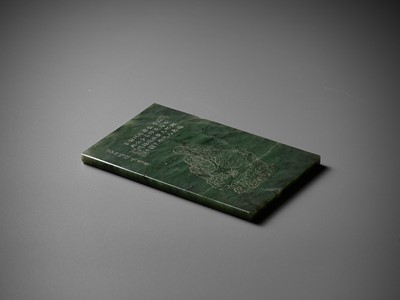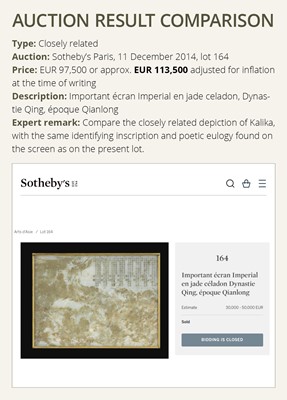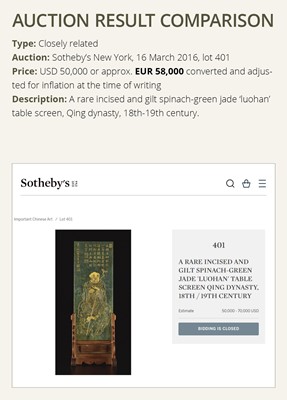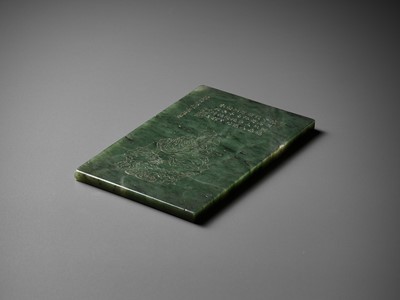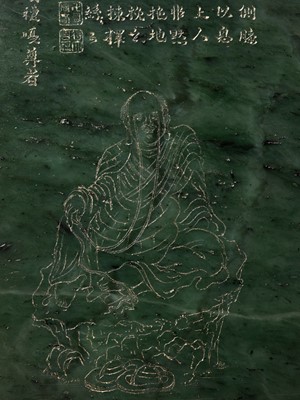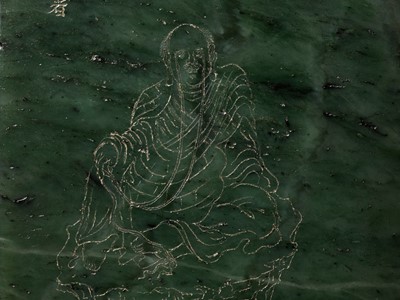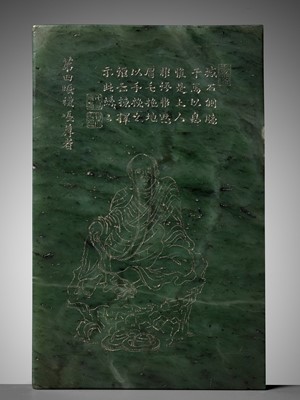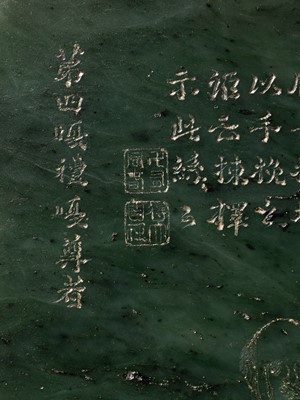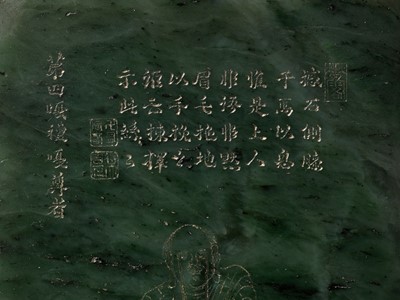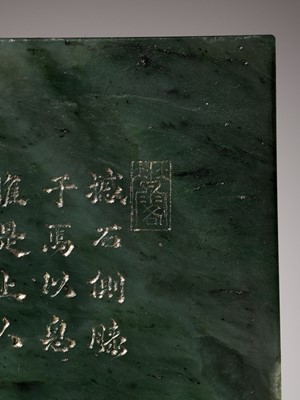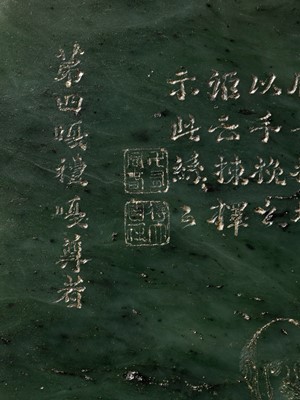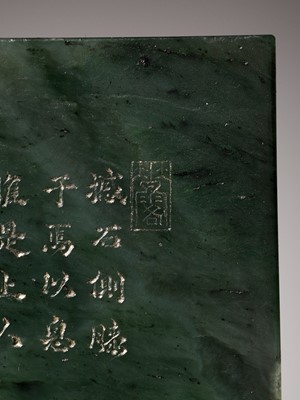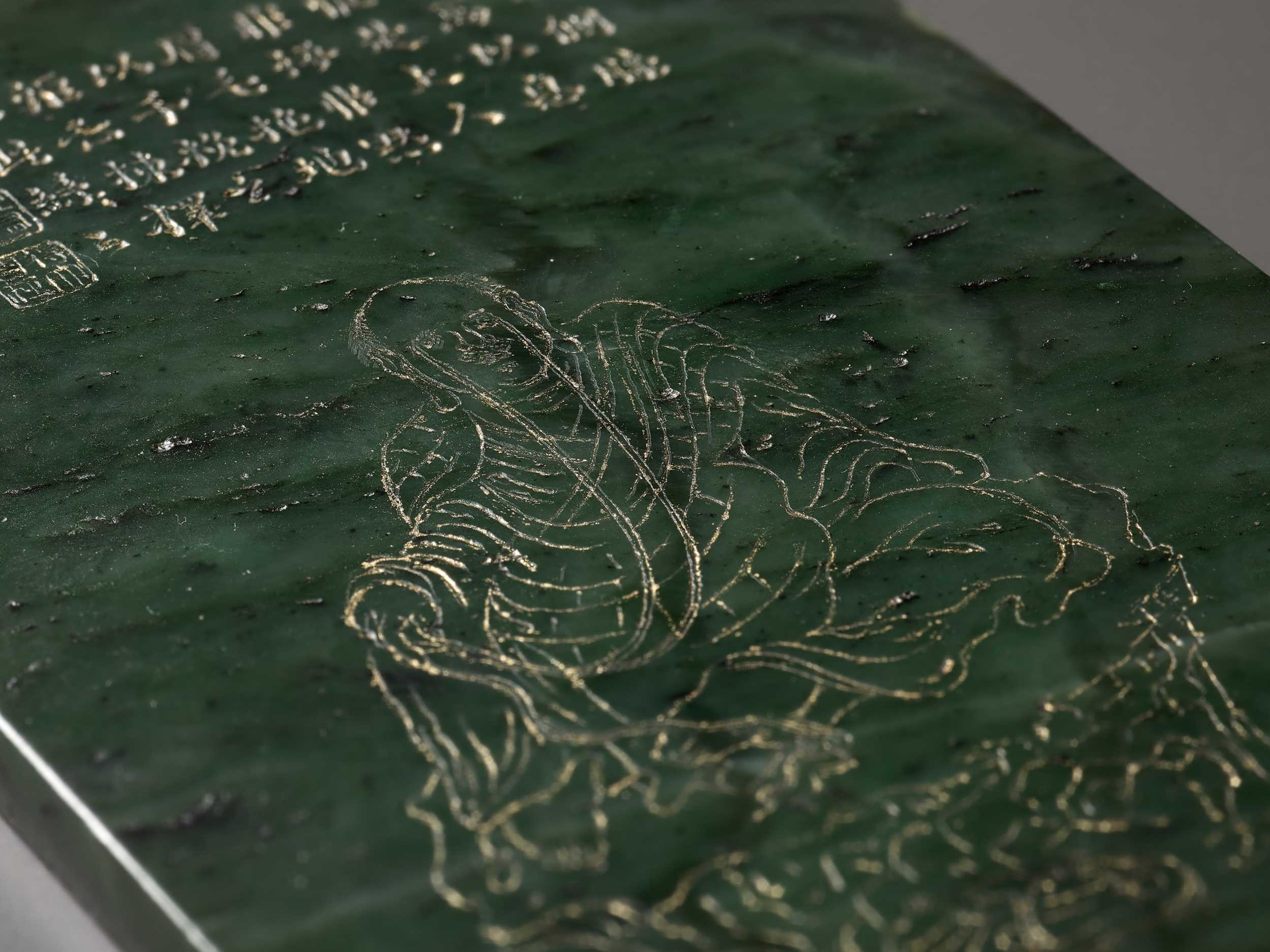10th Dec, 2022 11:00
Asian Art Holiday Sale
169
AN IMPERIAL SPINACH-GREEN JADE ‘LUOHAN’ PANEL AFTER GUANXIU (823-912 AD), WITH A POETIC EULOGY BY HONGLI (1711-1799)
貫休款御製羅漢弘曆(1711-1799)詩文碧玉板
Sold for €2,600
including Buyer's Premium
Opinion: Imperial jade plaques from this distinct group are exceedingly rare. It is impossible to say whether the present lot once served as a table screen, possibly within a group of sixteen, or if it was once part of an Imperial jade book, such as the example in the Chester Beatty Library, Dublin, which portrays all sixteen luohan with accompanying inscriptions (see literature comparison). Either way, the supreme skill level of the incision work overall, as well as the carefully chosen stone and the immaculate calligraphy, all very clearly reflect Imperial workshop quality, no less.
The poetic eulogy: Shaking the rock, he leans his knee on it and there takes his rest. It is only this superior being, neither speaking nor silent, who has such eyebrows that trail to the ground. As he pulls them up by hand, does he not seem to be sorting through clouds, and this shows how very fine they are.
The author: Born Hongli, the fourth son of Yongzheng, Qianlong was the sixth Emperor of the Qing dynasty, reigning from 1735 to 1796. In 1796, he abdicated in favor of his son, Jiaqing, a filial act in order not to reign longer than his grandfather, the Kangxi Emperor, who ruled for 61 years. Despite his retirement, he retained ultimate power as the Emperor Emeritus until his death in 1799, making him one of the longest-reigning monarchs in history, and, dying at the age of 87, one of the longest-lived. As a capable and cultured ruler inheriting a thriving empire, during his long reign, the Qing Empire reached its most splendid and prosperous era, boasting a large population and economy.
China, 1736-1795. Superbly incised and gilt with the luohan Kalika seated in a relaxed pose atop a rocky outcrop, a pair of sandals on the ground below him, all beneath a minute inscription identifying him along with an Imperial eulogy, and three finely incised seal marks. In one hand the luohan holds one of his extremely long eyebrows between two fingers. He is wearing loose-fitting monastic robes with well rendered folds, while the structure of the rock below is expressively incised as well.
Provenance: From a noted private collection in Paris, France.
Condition: Very good condition with minor wear, natural imperfections to the stone, and minuscule nicks here and there. The gilt to the incisions is partially faded and lost. Smooth silky matte polish overall, as expected on this type of imperial jade plaque.
Weight: 265.6 g
Dimensions: Size 14.1 x 9 cm
The distinctively exaggerated depiction of the luohan Kalika, finely incised and gilt on the present jade panel, originated with the famous Five Dynasties painter Guanxiu (823-912 AD), whose hugely influential rendition of each luohan's iconography is seen on a number of Qing dynasty Imperial jade carvings and other works of art.
In 1757, Qianlong embarked upon a tour of inspection in southern China and visited Hangzhou where he was stationed near Shengyin Si, the monastery that owned the original paintings of the sixteen luohans by Guanxiu. The emperor believed the paintings to be the same set that had been recorded in the Xuanhe Huapu, the inventory of the Song dynasty emperor Huizong. Upon examining the paintings, it is reported that Qianlong wrote a poetic eulogy to each luohan image, renumbering them and providing a translation of their names in Chinese, see Nick Pearce, 'Images of Guanxiu's Sixteen Luohan in Eighteenth-Century China', Apollo, February 2003, pp. 25-31.
In 1764, the head abbot at the Shengyin Si monastery, Master Mingshui, instructed local stone engravers to copy the sixteen portraits, incising Guangxiu's lines as well as the emperor's calligraphy and seals onto sixteen large flat stones that were embedded into the sixteen sides of the Miaoxiang marble Pagoda, illustrated in the exhibition catalog The Emperor's Private Paradise, Treasures from the Forbidden City, Peabody Essex Museum, Salem, 2010, fig. 23.
In the following decades, the Qianlong emperor had artisans reproduce the images in a variety of mediums, including incising them on jade plaques. A Qianlong period jade book in the Chester Beatty Library, Dublin portraying sixteen luohan with accompanying inscriptions, is illustrated in William Watson, Chinese Jade Books in the Chester Beatty Library, Dublin, 1963, pls. 6-7.
Literature comparison:
Compare a stone rubbing after the set attributed to Guanxiu, possibly by Ding Guanpeng, in the collection of the Metropolitan Museum of Art, accession number 59.195.16.
Auction result comparison:
Type: Closely related
Auction: Sotheby’s Paris, 11 December 2014, lot 164
Price: EUR 97,500 or approx. EUR 113,500 adjusted for inflation at the time of writing
Description: Important écran Imperial en jade celadon, Dynastie Qing, époque Qianlong
Expert remark: Compare the closely related depiction of Kalika, with the same identifying inscription and poetic eulogy found on the screen as on the present lot.
Auction result comparison:
Type: Closely related
Auction: Sotheby’s New York, 16 March 2016, lot 401
Estimate: USD 50,000 or approx. EUR 58,000 converted and adjusted for inflation at the time of writing
Description: A rare incised and gilt spinach-green jade ‘luohan’ table screen, Qing dynasty, 18th-19th century.
貫休款御製羅漢弘曆(1711-1799)詩文碧玉板
中國,1736-1795年。雕刻精美,鎏金嘎禮嘎尊者以游戲姿坐在岩石上,腳下放著一雙涼鞋。羅漢一隻手二指之間夾著他的長眉。他身著寬鬆的僧袍,褶皺紋理流暢。
專家注釋:御製玉牌極為罕見,不能確定它是否曾是桌屏,或者它曾經是皇家玉冊的一部分。例如都柏林切斯特比蒂圖書館中的例子,可見十六個羅漢,都附有銘文(見文獻比較)。不管怎樣,整體的刀工工藝水平,以及精心挑選的玉料和完美無瑕的書法,都非常清楚地體現了皇家作坊的品質。
詩句:撼石側膝,於焉以息,惟是上人,非語非默,眉毛拖地,以手輓之,詎雲揀擇,示此絲絲
作者:乾隆為雍正第四子,名弘曆,是清朝第六位皇帝,在位時間為1735年至1796年。1796年,他為了不超過祖父康熙的在位時間,退位給嘉慶。他是歷史上在位時間最長的君主之一,87歲時去世,也是最長壽的君主之一。在他的統治時期,清帝國達到了最輝煌、最繁榮的時代,人口眾多,經濟發達。
來源:法國巴黎知名私人收藏
品相:狀況極好,有輕微磨損,玉料有自然瑕疵,很多微小的刻痕。切口的鎏金部分褪色並丟失。整體光滑瑩潤,正如皇家玉冊的預期。
重量:265.6克
尺寸:14.1 x 9厘米
這塊玉冊上鎏金羅漢嘎禮嘎尊者,畫像出自五代著名畫家貫休(公元823-912年)之手,其對羅漢各像的影響巨大。
乾隆南巡,駐紮在錢塘聖因寺附近,這裡有貫休得十六應真像原圖。皇帝認為這些畫與宋徽宗清冊《宣和畫譜》中記載的相同。據說,乾隆在檢查這些畫作後,為每一幅羅漢像都題跋,並重新進行編號,為做了中文名字翻譯,Nick Pearce, ‘Images of Guanxiu’s Sixteen Luohan in Eighteenth-Century China’,阿波羅, 2003年2月,第25-31頁。
在接下來的幾十年裡,乾隆皇帝讓工匠們用各種材料製作十六應真像,包括將它們刻在玉冊上。都柏林Chester Beatty圖書館收藏的乾隆時期玉書,描繪了十六羅漢並附有銘文,插圖載於William Watson,《Chinese Jade Books in the Chester Beatty Lbrary》,都柏林,1963年,圖6-7。
文獻比較:
比較一件貫休款的石刻拓片,可能是丁關鵬所作,收藏於大都會藝術博物館收藏,收藏編號為59.195.16。
拍賣結果比較:
形制:非常相近
拍賣:巴黎蘇富比,2014年12月11日,lot 164
價格:EUR 97,500(相當於今日EUR 113,500)
描述:乾隆御製青花瓷玉屏風
專家評論:比較同樣描繪嘎禮嘎尊者的形式,以及相同的詩詞、悼詞。
拍賣結果比較:
形制:非常相近
拍賣:紐約蘇富比,2016年3月16日,lot 401
估價:USD 50,000(相當於今日EUR 58,000)
描述:清代十八至十九世紀菠菜綠鎏金羅漢玉屏風
Opinion: Imperial jade plaques from this distinct group are exceedingly rare. It is impossible to say whether the present lot once served as a table screen, possibly within a group of sixteen, or if it was once part of an Imperial jade book, such as the example in the Chester Beatty Library, Dublin, which portrays all sixteen luohan with accompanying inscriptions (see literature comparison). Either way, the supreme skill level of the incision work overall, as well as the carefully chosen stone and the immaculate calligraphy, all very clearly reflect Imperial workshop quality, no less.
The poetic eulogy: Shaking the rock, he leans his knee on it and there takes his rest. It is only this superior being, neither speaking nor silent, who has such eyebrows that trail to the ground. As he pulls them up by hand, does he not seem to be sorting through clouds, and this shows how very fine they are.
The author: Born Hongli, the fourth son of Yongzheng, Qianlong was the sixth Emperor of the Qing dynasty, reigning from 1735 to 1796. In 1796, he abdicated in favor of his son, Jiaqing, a filial act in order not to reign longer than his grandfather, the Kangxi Emperor, who ruled for 61 years. Despite his retirement, he retained ultimate power as the Emperor Emeritus until his death in 1799, making him one of the longest-reigning monarchs in history, and, dying at the age of 87, one of the longest-lived. As a capable and cultured ruler inheriting a thriving empire, during his long reign, the Qing Empire reached its most splendid and prosperous era, boasting a large population and economy.
China, 1736-1795. Superbly incised and gilt with the luohan Kalika seated in a relaxed pose atop a rocky outcrop, a pair of sandals on the ground below him, all beneath a minute inscription identifying him along with an Imperial eulogy, and three finely incised seal marks. In one hand the luohan holds one of his extremely long eyebrows between two fingers. He is wearing loose-fitting monastic robes with well rendered folds, while the structure of the rock below is expressively incised as well.
Provenance: From a noted private collection in Paris, France.
Condition: Very good condition with minor wear, natural imperfections to the stone, and minuscule nicks here and there. The gilt to the incisions is partially faded and lost. Smooth silky matte polish overall, as expected on this type of imperial jade plaque.
Weight: 265.6 g
Dimensions: Size 14.1 x 9 cm
The distinctively exaggerated depiction of the luohan Kalika, finely incised and gilt on the present jade panel, originated with the famous Five Dynasties painter Guanxiu (823-912 AD), whose hugely influential rendition of each luohan's iconography is seen on a number of Qing dynasty Imperial jade carvings and other works of art.
In 1757, Qianlong embarked upon a tour of inspection in southern China and visited Hangzhou where he was stationed near Shengyin Si, the monastery that owned the original paintings of the sixteen luohans by Guanxiu. The emperor believed the paintings to be the same set that had been recorded in the Xuanhe Huapu, the inventory of the Song dynasty emperor Huizong. Upon examining the paintings, it is reported that Qianlong wrote a poetic eulogy to each luohan image, renumbering them and providing a translation of their names in Chinese, see Nick Pearce, 'Images of Guanxiu's Sixteen Luohan in Eighteenth-Century China', Apollo, February 2003, pp. 25-31.
In 1764, the head abbot at the Shengyin Si monastery, Master Mingshui, instructed local stone engravers to copy the sixteen portraits, incising Guangxiu's lines as well as the emperor's calligraphy and seals onto sixteen large flat stones that were embedded into the sixteen sides of the Miaoxiang marble Pagoda, illustrated in the exhibition catalog The Emperor's Private Paradise, Treasures from the Forbidden City, Peabody Essex Museum, Salem, 2010, fig. 23.
In the following decades, the Qianlong emperor had artisans reproduce the images in a variety of mediums, including incising them on jade plaques. A Qianlong period jade book in the Chester Beatty Library, Dublin portraying sixteen luohan with accompanying inscriptions, is illustrated in William Watson, Chinese Jade Books in the Chester Beatty Library, Dublin, 1963, pls. 6-7.
Literature comparison:
Compare a stone rubbing after the set attributed to Guanxiu, possibly by Ding Guanpeng, in the collection of the Metropolitan Museum of Art, accession number 59.195.16.
Auction result comparison:
Type: Closely related
Auction: Sotheby’s Paris, 11 December 2014, lot 164
Price: EUR 97,500 or approx. EUR 113,500 adjusted for inflation at the time of writing
Description: Important écran Imperial en jade celadon, Dynastie Qing, époque Qianlong
Expert remark: Compare the closely related depiction of Kalika, with the same identifying inscription and poetic eulogy found on the screen as on the present lot.
Auction result comparison:
Type: Closely related
Auction: Sotheby’s New York, 16 March 2016, lot 401
Estimate: USD 50,000 or approx. EUR 58,000 converted and adjusted for inflation at the time of writing
Description: A rare incised and gilt spinach-green jade ‘luohan’ table screen, Qing dynasty, 18th-19th century.
貫休款御製羅漢弘曆(1711-1799)詩文碧玉板
中國,1736-1795年。雕刻精美,鎏金嘎禮嘎尊者以游戲姿坐在岩石上,腳下放著一雙涼鞋。羅漢一隻手二指之間夾著他的長眉。他身著寬鬆的僧袍,褶皺紋理流暢。
專家注釋:御製玉牌極為罕見,不能確定它是否曾是桌屏,或者它曾經是皇家玉冊的一部分。例如都柏林切斯特比蒂圖書館中的例子,可見十六個羅漢,都附有銘文(見文獻比較)。不管怎樣,整體的刀工工藝水平,以及精心挑選的玉料和完美無瑕的書法,都非常清楚地體現了皇家作坊的品質。
詩句:撼石側膝,於焉以息,惟是上人,非語非默,眉毛拖地,以手輓之,詎雲揀擇,示此絲絲
作者:乾隆為雍正第四子,名弘曆,是清朝第六位皇帝,在位時間為1735年至1796年。1796年,他為了不超過祖父康熙的在位時間,退位給嘉慶。他是歷史上在位時間最長的君主之一,87歲時去世,也是最長壽的君主之一。在他的統治時期,清帝國達到了最輝煌、最繁榮的時代,人口眾多,經濟發達。
來源:法國巴黎知名私人收藏
品相:狀況極好,有輕微磨損,玉料有自然瑕疵,很多微小的刻痕。切口的鎏金部分褪色並丟失。整體光滑瑩潤,正如皇家玉冊的預期。
重量:265.6克
尺寸:14.1 x 9厘米
這塊玉冊上鎏金羅漢嘎禮嘎尊者,畫像出自五代著名畫家貫休(公元823-912年)之手,其對羅漢各像的影響巨大。
乾隆南巡,駐紮在錢塘聖因寺附近,這裡有貫休得十六應真像原圖。皇帝認為這些畫與宋徽宗清冊《宣和畫譜》中記載的相同。據說,乾隆在檢查這些畫作後,為每一幅羅漢像都題跋,並重新進行編號,為做了中文名字翻譯,Nick Pearce, ‘Images of Guanxiu’s Sixteen Luohan in Eighteenth-Century China’,阿波羅, 2003年2月,第25-31頁。
在接下來的幾十年裡,乾隆皇帝讓工匠們用各種材料製作十六應真像,包括將它們刻在玉冊上。都柏林Chester Beatty圖書館收藏的乾隆時期玉書,描繪了十六羅漢並附有銘文,插圖載於William Watson,《Chinese Jade Books in the Chester Beatty Lbrary》,都柏林,1963年,圖6-7。
文獻比較:
比較一件貫休款的石刻拓片,可能是丁關鵬所作,收藏於大都會藝術博物館收藏,收藏編號為59.195.16。
拍賣結果比較:
形制:非常相近
拍賣:巴黎蘇富比,2014年12月11日,lot 164
價格:EUR 97,500(相當於今日EUR 113,500)
描述:乾隆御製青花瓷玉屏風
專家評論:比較同樣描繪嘎禮嘎尊者的形式,以及相同的詩詞、悼詞。
拍賣結果比較:
形制:非常相近
拍賣:紐約蘇富比,2016年3月16日,lot 401
估價:USD 50,000(相當於今日EUR 58,000)
描述:清代十八至十九世紀菠菜綠鎏金羅漢玉屏風
Zacke Live Online Bidding
Our online bidding platform makes it easier than ever to bid in our auctions! When you bid through our website, you can take advantage of our premium buyer's terms without incurring any additional online bidding surcharges.
To bid live online, you'll need to create an online account. Once your account is created and your identity is verified, you can register to bid in an auction up to 12 hours before the auction begins.
Intended Spend and Bid Limits
When you register to bid in an online auction, you will need to share your intended maximum spending budget for the auction. We will then review your intended spend and set a bid limit for you. Once you have pre-registered for a live online auction, you can see your intended spend and bid limit by going to 'Account Settings' and clicking on 'Live Bidding Registrations'.
Your bid limit will be the maximum amount you can bid during the auction. Your bid limit is for the hammer price and is not affected by the buyer’s premium and VAT. For example, if you have a bid limit of €1,000 and place two winning bids for €300 and €200, then you will only be able to bid €500 for the rest of the auction. If you try to place a bid that is higher than €500, you will not be able to do so.
Online Absentee and Telephone Bids
You can now leave absentee and telephone bids on our website!
Absentee Bidding
Once you've created an account and your identity is verified, you can leave your absentee bid directly on the lot page. We will contact you when your bids have been confirmed.
Telephone Bidding
Once you've created an account and your identity is verified, you can leave telephone bids online. We will contact you when your bids have been confirmed.
Classic Absentee and Telephone Bidding Form
You can still submit absentee and telephone bids by email or fax if you prefer. Simply fill out the Absentee Bidding/Telephone bidding form and return it to us by email at office@zacke.at or by fax at +43 (1) 532 04 52 20. You can download the PDF from our Upcoming Auctions page.
How-To Guides
How to Create Your Personal Zacke Account
How to Register to Bid on Zacke Live
How to Leave Absentee Bids Online
How to Leave Telephone Bids Online
中文版本的操作指南
创建新账号
注册Zacke Live在线直播竞拍(免平台费)
缺席投标和电话投标
Third-Party Bidding
We partner with best-in-class third-party partners to make it easy for you to bid online in the channel of your choice. Please note that if you bid with one of our third-party online partners, then there will be a live bidding surcharge on top of your final purchase price. You can find all of our fees here. Here's a full list of our third-party partners:
- 51 Bid Live
- EpaiLive
- ArtFoxLive
- Invaluable
- LiveAuctioneers
- the-saleroom
- lot-tissimo
- Drouot
Please note that we place different auctions on different platforms. For example, in general, we only place Chinese art auctions on 51 Bid Live.
Bidding in Person
You must register to bid in person and will be assigned a paddle at the auction. Please contact us at office@zacke.at or +43 (1) 532 04 52 for the latest local health and safety guidelines.
